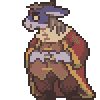
did you know that different kinds of animals have different reflective colors of their tapetum lucidum? dogs and cats usually have green reflections, crocodilians have orangey red, some fish have white, etc… reindeer tapetum lucidum even change color over the seasons, being yellow in the summer and blue in the winter
this has been on my mind for a really long time with regards to my polumorphim, though i never actually had the opportunity to draw it out until now. im not sure what color exactly their eyes should reflect, ive personally been torn between red, yellow, or white myself since ive started working with them. im not going to leave them without reflective eyes, due to the species being largely nocturnal and the tapetum lucidum is an adaptation for seeing in low light, but theres a wide variety of colors to pick from!
this has been on my mind for a really long time with regards to my polumorphim, though i never actually had the opportunity to draw it out until now. im not sure what color exactly their eyes should reflect, ive personally been torn between red, yellow, or white myself since ive started working with them. im not going to leave them without reflective eyes, due to the species being largely nocturnal and the tapetum lucidum is an adaptation for seeing in low light, but theres a wide variety of colors to pick from!
Category Artwork (Digital) / Miscellaneous
Species Exotic (Other)
Size 1500 x 1318px
File Size 679.6 kB
Listed in Folders
nah, theres certain things they cant change about themselves, like the color of their skin, fur, scales, their eyes, etc. despite the malleability of form there are still aspects that are consistent to the species, and the tapetum lucidum would be included with that
what I was able to pick up after very minimal research on the eye structures of these animals
alligator/croc - "Like many animals, gators have a lining in the back of the eye that reflects the light coming in through the pupil. This increases the gator's ability to see in low-light situations, such as muddy water or darkness -- but it also causes his eyes to shine red at night, giving away his location." source
yellow - seems to be an offshoot of green mostly, i can't find anything specific on it but lots of night dwellers have them, like nocturnal lemurs, mountain lions, rats, raccoons, coyotes etc. it seems focused more on night scavengers rather than specifically night Hunters though if that makes a difference
fish - "Some species have a tapetum, a reflective layer which bounces light that passes through the retina back through it again. This enhances sensitivity in low light conditions, such as nocturnal and deep sea species, by giving photons a second chance to be captured by photoreceptors. However this comes at a cost of reduced resolution. Some species are able to effectively turn their tapetum off in bright conditions, with a dark pigment layer covering it as needed." source (? it doesn't explicitly say whether this is why some fish shine white, but the more i poke around the more likely it seems)
alligator/croc - "Like many animals, gators have a lining in the back of the eye that reflects the light coming in through the pupil. This increases the gator's ability to see in low-light situations, such as muddy water or darkness -- but it also causes his eyes to shine red at night, giving away his location." source
yellow - seems to be an offshoot of green mostly, i can't find anything specific on it but lots of night dwellers have them, like nocturnal lemurs, mountain lions, rats, raccoons, coyotes etc. it seems focused more on night scavengers rather than specifically night Hunters though if that makes a difference
fish - "Some species have a tapetum, a reflective layer which bounces light that passes through the retina back through it again. This enhances sensitivity in low light conditions, such as nocturnal and deep sea species, by giving photons a second chance to be captured by photoreceptors. However this comes at a cost of reduced resolution. Some species are able to effectively turn their tapetum off in bright conditions, with a dark pigment layer covering it as needed." source (? it doesn't explicitly say whether this is why some fish shine white, but the more i poke around the more likely it seems)
yea its mostly just what reflects which color, which can be generally grouped into predators, prey, scavengers, and things like that but there's also clearly more specialized eyes and reasons that the colors are different but nothing is very clear as to What it is that's making them reflect those colors so that info was all i was able to pick up..
personally i think its kind of cool thinking they'd have some sort of pigment layer that stretches back over their retinas during the day and that their enhanced night vision has to do with light being reflected in the eye multiple times, just cus it sounds neat, so white would be my pick but aesthetically? i like them all. u could always just come up with ur own reason that they reflect different colors since it really seems to vary from animal to animal
personally i think its kind of cool thinking they'd have some sort of pigment layer that stretches back over their retinas during the day and that their enhanced night vision has to do with light being reflected in the eye multiple times, just cus it sounds neat, so white would be my pick but aesthetically? i like them all. u could always just come up with ur own reason that they reflect different colors since it really seems to vary from animal to animal
I thiiink it has to do with what wavelength the light receptors are most sensitive to. Most mammals are red-green blind and as far as I know, crocodiles don't see colour, while fish often have tetrachromatic vision (don't know about the white-reflecting species, but the pet catfish reflect orange). If your species has similar vision to humans (trichromatic and most sensitive for green), then either green or white would be the best choice.
im definitely more of a science type of guy when it comes to my polumorphim at least, so the eye shine wouldnt be about aesthetics so much as it is to resemble a sense of realism with my world building :0c
ty for the input and !!! gosh seeing more anthros w eye shine would be Cool imo
ty for the input and !!! gosh seeing more anthros w eye shine would be Cool imo
I love getting into sciencey stuff like this!
okay, so I guess the major question is why do they have different colors, like why would it matter which color, or does it matter at all, right?
Looked up some stuff and this article talks about why reindeer eyes change - which might be key to why other animal eyes are different. It's due to how much light there is. When reindeer are cast into months of darkness from polar nights, their eyes have to adjust to being in the dark for so long ((I assume this would be with some sort of histone epigenetic switch if you're familiar with those, but that's kind of besides the point)) and so their eyes dilate for months. Now, this dilation causes the fibers that make up the tapetum to get pushed closer and closer together, thus changing how much/which light is reflected. More gaps=yellow, less gaps=blue. The article does a bit more of a sciencey explanation of it, but that's my interpretation of what it says.
Furthermore, the color seems to indicate light sensitivity! Blue=more sensitive to light, which makes sense because they live in darkness, and they'd need to be able to detect even the smallest hint of light as opposed to yellow.
anyway some of the things the article was talking about.. went way over my head lol. but hopefully this offers some sort of help? I think that it indicates a couple things:
1. one single species can have different tapetum lucidums, so if your species has it, you don't have to decide on just one color for the entirety of the species
and
2. the tapetum lucidum colors seem to be dependent on how much light they're exposed to in their environment
okay, so I guess the major question is why do they have different colors, like why would it matter which color, or does it matter at all, right?
Looked up some stuff and this article talks about why reindeer eyes change - which might be key to why other animal eyes are different. It's due to how much light there is. When reindeer are cast into months of darkness from polar nights, their eyes have to adjust to being in the dark for so long ((I assume this would be with some sort of histone epigenetic switch if you're familiar with those, but that's kind of besides the point)) and so their eyes dilate for months. Now, this dilation causes the fibers that make up the tapetum to get pushed closer and closer together, thus changing how much/which light is reflected. More gaps=yellow, less gaps=blue. The article does a bit more of a sciencey explanation of it, but that's my interpretation of what it says.
Furthermore, the color seems to indicate light sensitivity! Blue=more sensitive to light, which makes sense because they live in darkness, and they'd need to be able to detect even the smallest hint of light as opposed to yellow.
anyway some of the things the article was talking about.. went way over my head lol. but hopefully this offers some sort of help? I think that it indicates a couple things:
1. one single species can have different tapetum lucidums, so if your species has it, you don't have to decide on just one color for the entirety of the species
and
2. the tapetum lucidum colors seem to be dependent on how much light they're exposed to in their environment
Gonna go with what I've seen from my dogs and say that since your character has blue eyes, the shine should be red. My blue eyed dogs all had a red eye shine, while my brown eyed dogs had green or yellow. One had one blue and one brown eye and had one eye reflect red and one reflect green. It was pretty cool.

 FA+
FA+


























Comments